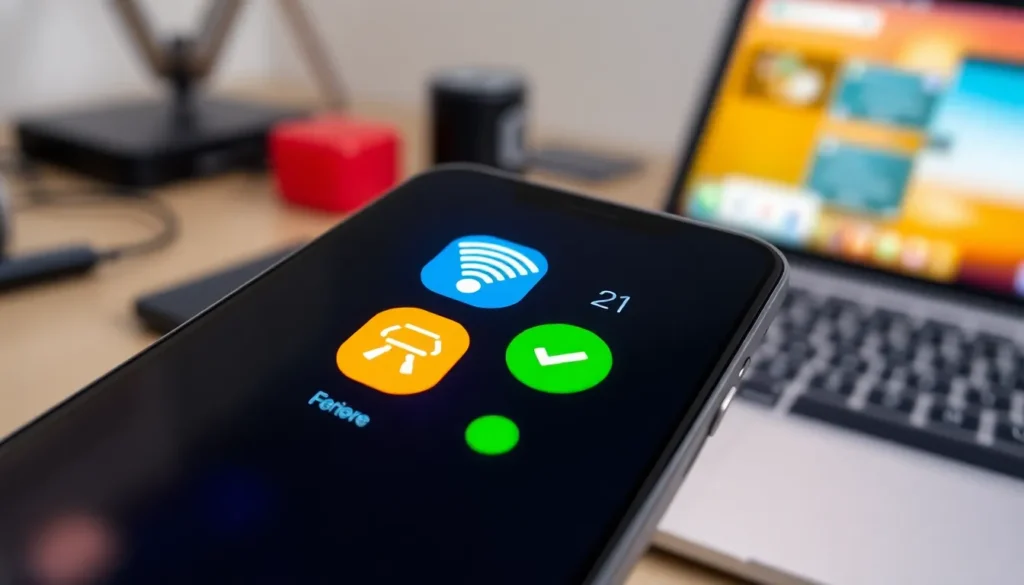Table of Contents
ToggleIn today’s tech-savvy world, understanding device status indicators can feel like deciphering an ancient language. Those little lights and symbols on gadgets might seem like mere decoration, but they hold the key to a smoother tech experience. Imagine this: your printer’s blinking light could either mean it’s ready to print your masterpiece or staging a dramatic protest.
Knowing what these indicators mean can save time, frustration, and possibly a few hair-pulling moments. Whether it’s your smartphone, laptop, or smart fridge, these signals are your gadgets’ way of communicating. So let’s dive into the colorful world of device status indicators and uncover how they can turn you into a tech whisperer. After all, who wouldn’t want to impress friends with their newfound knowledge of blinking lights?
Overview of Device Status Indicators
Device status indicators communicate essential information about gadget performance and functionality. Lights, symbols, and textual feedback appear on devices such as printers, smartphones, and laptops. These indicators reveal crucial details, like power status, connectivity, and error messages.
Understanding these signals enhances user experience significantly. For instance, a blinking light may indicate an ongoing process, while a solid light often signifies readiness. Colors also carry meaning: green typically indicates normal operation, while red often points to errors or issues requiring attention.
Users encounter various types of indicators across devices. Alarm indicators alert users to critical notifications. Connection status indicators inform users about Wi-Fi or Bluetooth connectivity. Battery status indicators provide information about remaining power or charging status.
Interpreting these indicators becomes increasingly important in troubleshooting potential problems. Recognizing a low battery indicator prevents device shutdown during crucial moments. Visual symbols on smartphones often simplify user interactions by providing instant feedback.
Many manufacturers adopt standardized iconography to aid identification and reduce confusion. Familiarity with these universal symbols allows users to navigate devices more effectively. By learning the meanings behind these indicators, users demystify technology and enhance their expertise.
Gaining this understanding fosters a smoother tech experience and boosts confidence when operating devices. Each indicator serves a purpose in simplifying interactions and streamlining performance. Users are encouraged to explore their gadgets, ensuring they leverage these tools for better understanding and efficiency.
Importance of Device Status Indicators

Device status indicators play a vital role in the functionality of technology. Understanding these signals helps users optimize their experience and device performance.
Enhancing User Experience
Users benefit from clear device status indicators through improved interaction with gadgets. Each light or symbol conveys important information. A solid green light typically indicates that a device is ready for use. Likewise, a blinking light often shows that an action is in progress. Knowledge of these signals minimizes confusion and frustration. Interpreting these indicators transforms everyday tech interactions into smoother experiences. Familiarity with device status can impress peers, showcasing a deeper understanding of technology.
Ensuring Device Efficiency
Device performance largely depends on the interpretation of status indicators. Recognizing error symbols prevents potential issues from escalating. For instance, a low battery light alerts users to charge their devices, avoiding interruptions during critical tasks. Connection status indicators facilitate seamless connectivity. Users easily manage Wi-Fi and Bluetooth settings with timely alerts. Familiarity with these signals enhances troubleshooting efforts and prolongs device longevity. Effective monitoring of indicators allows for proactive maintenance, ensuring that devices operate efficiently for longer periods.
Types of Device Status Indicators
Device status indicators come in various forms, each serving a unique purpose. Understanding these types improves overall user interaction.
Visual Indicators
Visual indicators primarily include lights, symbols, and display screens. Lights often signify power status or connectivity. For instance, a green light indicates an active connection, while a red light may represent an error or low battery. Symbols displayed on screens provide additional context, such as a Wi-Fi icon that signifies connectivity status. These visual cues enhance user awareness and help facilitate quicker responses to potential issues, boosting device performance.
Audio Indicators
Audio indicators rely on sounds to convey essential device information. Alerts can range from simple beeps to complex tones, each associated with specific alerts. For example, a series of rapid beeps may indicate a critical error, while a single sound might signify successful completion of a task. Different devices utilize distinct audio signals to clearly communicate status. Understanding these sounds can play a critical role in troubleshooting and ensuring device functionality, further alleviating potential frustrations.
Tactile Indicators
Tactile indicators provide physical feedback through vibrations or touch sensitivity. Many smartphones, for example, use vibrations to indicate incoming calls or notifications. A strong vibration might signal an urgent alert, whereas a gentle pulse suggests a less critical message. This category also includes devices that feature buttons or switches providing tactile responses for power status or mode changes. Recognizing tactile cues helps users stay informed while engaging with their devices, enhancing the overall experience.
Best Practices for Implementing Device Status Indicators
Implementing effective device status indicators plays a crucial role in enhancing user experiences. Following a few best practices can lead to universally understood and clear communication.
Design Considerations
Clarity remains essential in design. Opt for simple icons that convey meaning at a glance. Use consistent color schemes; for example, green typically indicates normal operation while red signals problems. Ensure that symbols reflect common industry standards to avoid confusion. Position indicators where users can easily see them, promoting spontaneous awareness. Balance aesthetic appeal with functionality, allowing users to associate visuals with specific device operations quickly.
User-Centric Approaches
Focusing on the user’s perspective aids interpretation. Gather feedback to understand common challenges when interpreting indicators. Provide contextual help, such as tooltips, to explain what each indicator means during usage. Offer visual and auditory options to cater to diverse preferences and requirements. Incorporate prominent designs for critical alerts, ensuring users can prioritize attention to urgent issues effectively. Regular updates and adjustments to these indicators can align with user needs, enhancing overall satisfaction.
Understanding device status indicators is essential for anyone looking to optimize their tech experience. By familiarizing themselves with these visual, audio, and tactile signals, users can navigate their devices with confidence and efficiency. Recognizing what each indicator signifies allows for quicker troubleshooting and proactive maintenance, ultimately prolonging device life.
Clear and consistent indicators not only enhance user understanding but also transform how individuals interact with technology. As users become more adept at interpreting these signals, they can enjoy smoother operations and avoid potential frustrations. Embracing this knowledge empowers users to make the most of their devices and simplifies everyday tech interactions.







